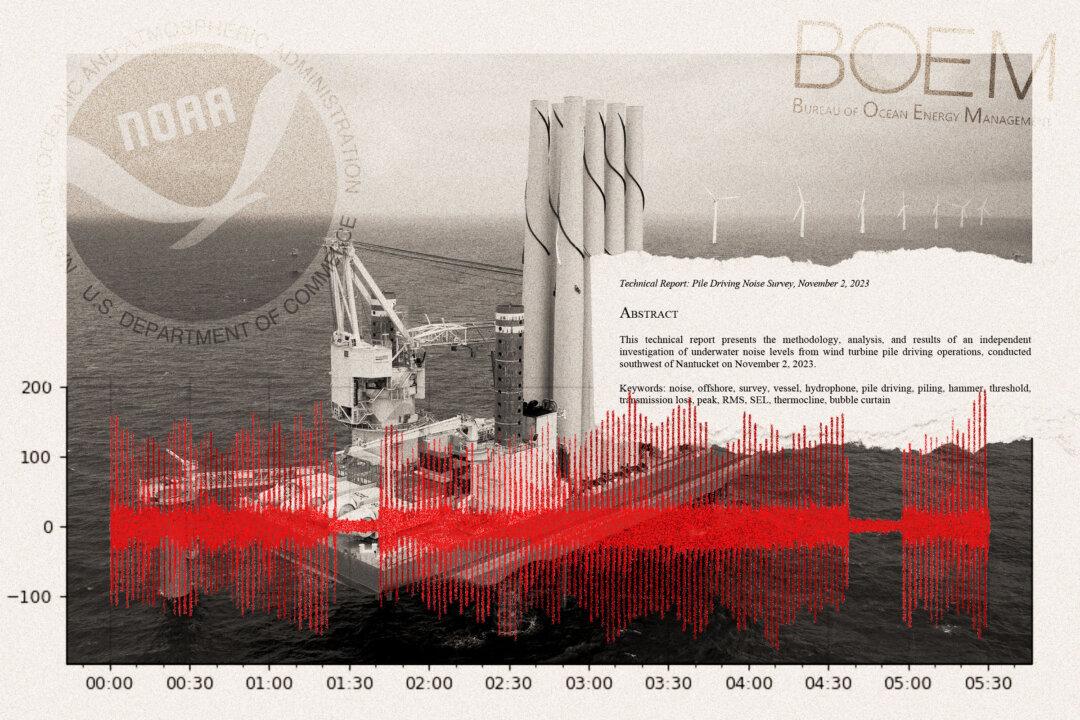The industrialization of the Atlantic Ocean is underway. South Fork Wind, America’s first utility-scale offshore wind farm, has begun delivering power to Long Island, New York.
“First power has started flowing to the grid,” Ryan Ferguson, Orsted’s head of corporate communications for the Americas, told The Epoch Times via email.
“Installation of all array cables, 13 foundations, including for 12 wind turbine generators (WTGs), the offshore substation, and five turbines has been successfully completed, with commissioning activities and installation of the remaining WTGs ongoing.”
This is a huge construction project, yet other planned wind farms are far more massive.
To describe what’s happening along the eastern coast of the United States, The Epoch Times examined construction documents for South Fork Wind and Atlantic Shores Offshore Wind, two of the 29 active offshore wind lease areas.
Foreign companies are big players in American offshore wind developments.
South Fork Wind is a 50/50 joint venture between Orsted, the Danish energy giant, and Eversource, New England’s largest energy company. The 12-turbine wind farm is being built 19 miles southeast of Block Island, Rhode Island.
Atlantic Shores Offshore Wind is a 50/50 joint venture between Shell New Energies US, a subsidiary of the British company Royal Dutch Shell PLC, and EDF-RE Offshore Development, part of a multinational electric utility owned by the French government.
This wind farm encompasses two projects located 8.7 miles from Atlantic City and Long Beach Island, New Jersey. If both are completed, 200 wind turbines, each possibly 1,047 feet tall, will stand in straight rows on the horizon.
Atlantic Shores is located just to the north of the wind farm that was cancelled by Orsted on Nov. 1, 2023. A week later, Atlantic Shores said in a statement that its wind farm is still moving forward.
Atlantic Shores did not respond to requests for comment.
Size and Layout of the Wind Farms
South Fork Wind, with 12 turbines, covers an area of 13,700 acres, or 21 square miles, according to the BOEM record of decision.If all 200 windmills of the Atlantic Shores projects are installed, they will cover an area of 102,124 acres, or 160 square miles, according to its COP.
Both South Fork Wind and Atlantic Shores are installing turbines in a grid pattern of straight rows with one nautical mile (1.15 miles) between structures. The spacing follows guidance issued by the United States Coast Guard to allow search and rescue operations, according to Lissa Eng, national communications lead for renewable energy at BOEM.
Both South Fork Wind and Atlantic Shores use monopile foundations, which are extremely large pipes, for their windmills. “A monopile foundation typically consists of a single steel tubular section, comprised of several sections of rolled steel plate welded together,” states the South Fork Wind COP.
South Fork Wind monopiles are up to 36 feet in diameter. Its piles were sunk up to 150 feet into the sediment and extended above the water, which is 108 to 134 deep at the wind farm location.
Atlantic Shores monopiles will be up to 49 feet in diameter — big enough to contain a pickleball court. They will be sunk up to 197 feet into the ocean floor and will rise above the ocean, which is 121 feet deep off Atlantic City.
The prefabricated monopiles are transported to their locations by barges or other vessels. To install them, developers use crane vessels or jack-up vessels — barges with movable legs that can extend to the seabed to create stable, elevated construction platforms. The anchors and legs of the construction vessels cause temporary disturbances in the seabed.
During construction, the monopiles are placed on the seabed, leveled, and then pounded to the target depth with a hydraulic hammer. The pounding can take two to nine hours per monopile and causes noise that opponents say damages marine life.
“That is going to cause an area of mortality where they will actually kill fish larvae, invertebrates, just because of the noise impact,” Rich Hittinger, a former member of the Rhode Island Fisherman’s Advisory Board, told The Epoch Times. “And then they will have a much larger area where they will have behavioral modifications. So in other words, they might injure fish, or they might just chase them away. But that radius for impact is on the order of several miles in all directions. So that’s the biggest impact, but there are many other impacts.”
To help stabilize the monopiles, wind farm developers install what’s called “scour protection,” typically a huge pile of rocks, around the base.
Atlantic Shores estimates that the scour field will extend 269 feet in diameter around each monopile. Therefore, the maximum total footprint of each foundation would be 56,844 square feet or about 1.3 acres. This means there will be an 8-foot tall pile of rocks the size of a football field around each wind turbine.
Offshore Substations
All wind farms have one or more offshore substations (OSS), which collect electrical energy from multiple windmills, preparing the power to be transmitted to shore. They look like multilevel power plants positioned 150 to 200 feet above the sea, constructed on foundations similar to wind turbines.According to the South Fork Wind COP, the OSS consists of “a high voltage power transformer, reactor, and switchgears together with secondary medium voltage transformers, switchgears, and utility equipment, including heating, ventilation, and air conditioning systems.
The substation may also include a small permanent diesel generator, which will have a maximum power of up to 400 hp and up to a 500-gallon diesel tank with secondary containment.
Cables for Collecting Power
Each individual windmill generates kinetic energy that must be collected so it can be transferred to shore. This is accomplished via inter-array or inter-link cables — 6- to 12-inch cables buried in the seabed that connect windmills to each other and then to the offshore substation.Inter-array cables are typically laid in trenches 4 to 6 feet deep, although the maximum depth may be 10 feet. Trenches may be dug with a mechanical plow, which is pulled along the cable route by a ship; a jet plow, which uses water jets to create a channel; or a mechanical cutter, which uses a cutting wheel or excavation chain.
“Whatever is living there, they just dig it up and push it off to the side,” Mr. Hittinger said.
Once the cables are laid, the trenches are filled back in. In some locations, the cables are protected by piling on more rocks, bags of rocks, or concrete mattresses. According to South Fork Wind Farm documentation, the mattresses are 9-inch thick slabs of concrete, 8 feet by 20 feet in size, with embedded polymer rope handles.
South Fork Wind installed 18.6 miles of inter-array cable in trenches, which permanently disturbed up to 20.2 acres of the ocean floor.
Export Cables
High-voltage export cables, typically 8 to 12 inches in diameter, about the size of a dinner plate, carry power from the offshore substations to shore, where they connect to the land-based power grid.South Fork Wind has one export cable that comes ashore in East Hampton, New York, 66 miles from the wind farm. In its COP, the permanent footprint for the export cable is cited as 16 acres.
Atlantic Shores Offshore Wind has two New Jersey landfall sites for its export cables—Atlantic City, a distance of 12 miles from the wind farm, and Sea Girt, at 61 miles. The developer said it would designate areas of the ocean floor as export cable corridors, ranging from 1,000 to 5,900 feet wide.
Up to four cables will be in each corridor, along with horizontal directional drilling pits and cofferdams at the landfall sites. If all export cables are installed in both corridors, they will create a maximum permanent seafloor disturbance of .46 square miles, or 294.4 acres.
Once all other components are in place, the actual wind turbines, which spin as the wind blows, are installed. Powering up the wind turbines, called commissioning, is the last step in the construction process.
As described in the Atlantic Shores COP, these three-bladed rotor assemblies are mounted on a tower structure affixed to the foundation. The wind turbines use integrated sensors to sense wind direction and automatically turn into it. The spinning rotors drive variable-speed electric generators.
South Fork Wind is installing the newest wind turbine from Siemens Gamesa, which generates 11 megawatts of power. Each of the three blades is 318 feet long, creating a total rotor diameter — the circle traversed by the spinning blades — of 656 feet. The total height to the tip of the blade is less than 840 feet above the water.
Atlantic Shores has not yet selected a wind turbine generator model. In its COP, the developer said it may choose turbines with blades up to 453 feet long, with a maximum rotor diameter of 919 feet. Therefore, the turning blades for the windmills located off Atlantic City may reach a maximum height of 1,047 feet above the sea.
The 77-story Chrysler Building in New York City is 1,047 feet tall. If Atlantic Shores is fully built out, there may be 200 windmills as tall as the Chrysler Building off the coast of New Jersey.







